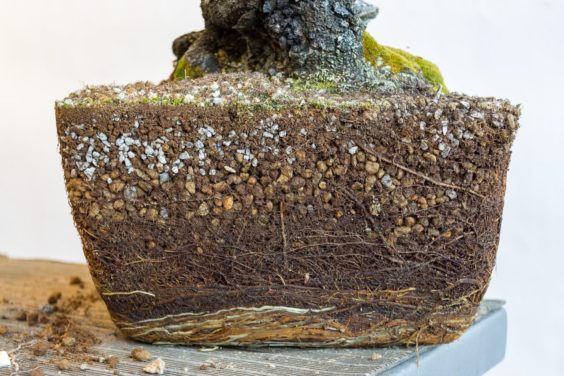For as important as roots are to healthy bonsai, we don’t often get a good look at how they grow in the pot. Few containers offer a view at what’s going on inside and we often disturb the roots with sickles or chop sticks when removing trees from their containers.
I got a particularly good view of the roots on a plum bonsai this year. I’ve been caring for and repotting the tree for the past 25 years so I’m familiar with how the roots grow, what size pot the tree likes and which soils work best for the tree.
Roots on a plum bonsai
Due to the speed with which the roots grow, I repot the tree every year. The soil mix is 50-60% akadama with the remainder consisting of pumice (the white particles) or kiryu (the yellow particles). The bottom half inch is straight pumice.
As is clear in the photo, there are more roots in the bottom half of the rootball than in the top half, and far more roots in the bottom inch than anywhere else – the course roots obscuring any view of the pumice layer.
Getting such a clear view of the roots made me wonder if there is any benefit to changing the distribution of roots in the pot – or if it’s even possible. The roots have looked like this every time I’ve repotted the tree, despite the different mixes I’ve used over the years. Clearly, the tree likes the available air and water near the bottom of the pot. Or is it the temperature? Or are plum roots programmed to grow as much and as low as possible?
It wouldn’t be tricky to answer these questions if I had enough similar trees to test different hypotheses. Just for fun, I rooted a number of cuttings from this tree a few years ago so I may get the chance to run some tests. That said, the tree typically produces the slow growth that I look for at this stage of development so there may be more pressing questions to investigate.
In the meantime, I’ll keep making small tweaks to the soil – different sizes, particle types, etc. – and see if any patterns emerge.
Subscribe to Bonsai Tonight
New Posts Delivered Every Tuesday and Friday

Edward Stanton says
Jonas, Do you also use pumice as an aeration/drainage layer on other trees? What size? And do you prefer pure pumice to lava or a mixture of pumice/lava for this layer? Thanks, Ed
Jonas Dupuich says
Good question Ed – I use a pumice later on most, but not all trees. The size is typically the same as the lowest layer of soil or sometimes one size bigger. I sometimes skip this layer when the pot is shallow. I generally make the decision to use it or not – or what size to use – based on the size of the pot rather than the variety.
I’ve used both pumice and/or lava. The main reason for the approach is to use particles that don’t break down, though I haven’t done controlled studies to really hone in on the differences, if any, in approach.
Geof Holmes says
Hi Jonas,
I think it is Pumice. Roots love it. Found that out many years ago on a Larch. Look how Randy’s collected material does in it.
Geof
Dana says
Oh, Jonas how can you just show us the bottom half of the tree like that?
Jonas Dupuich says
Ha – here you go: https://bonsaitonight.com/2018/04/03/spring-watering-tips/
Vinny Chirayil says
Hi Jonas, since you desire a slow growth of the tree at this stage of development, isn’t a finer soil mix more appropriate for it ? For developed trees, it seems the Japanese experts like the fact that akadama breaks down over a few years and turns into fine soil, which slows down the growth of the tree – a desirable feature for trees which are already developed. But when it is time to repot those trees, i wonder why they again use akadama, which would give a faster growth rate. Logically, they should be using fresh fine soil, since slow growth is the goal. Could you please share your thoughts on this ? Thanks in advance.
Jonas Dupuich says
Great question Vinny. I can’t speak for others, and I haven’t tested this in a controlled fashion, but I can relay the idea that recently repotted trees benefit from more air in the mix (or it’s at least easier to not keep the roots too wet after repotting). Once the new roots get established, the soil breaks down and the tree can manage the finer particles.
Depth of pot is another variable. I keep this plum in a deeper, and somewhat larger, pot than what I’d use in an exhibit because it’s easier to keep the tree looking good through the end of the growing season.
Pierre Seguin says
Hi Jonas,
Could it be that this species prefer wetter conditions? Because of gravity, the top layer is the driest and the bottom one the wettest. Some species prefer to top and middle section (ex: azalea).
Jonas Dupuich says
Hi Pierre – yes, it could be that plums prefer more moisture. The tree dries out quickly and appreciates the access to water, one of the reasons I keep it in a slightly larger pot.